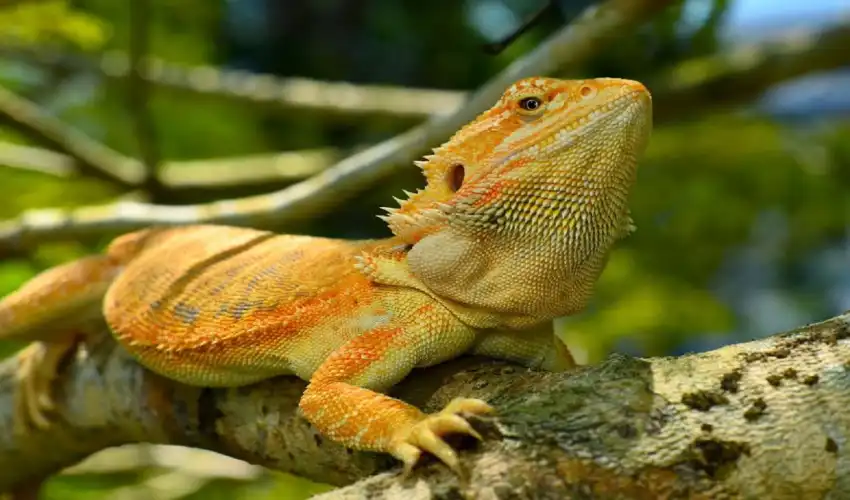
How to Identify a Red Bearded Dragon
The red bearded dragon, a captivating variation of the popular pet species Pogona vitticeps, boasts unique physical traits and characteristics that make it distinct from other color morphs. Understanding how to identify this vibrant reptile is essential for reptile enthusiasts, breeders, and prospective owners. This comprehensive guide will delve into the physical traits, behaviors, and unique considerations of red bearded dragons.
- Understanding the Basics: What Is a Red Bearded Dragon?
The red bearded dragon is a selectively bred morph of the central bearded dragon, known for its striking red coloration. While the standard bearded dragon is typically tan or brown, the red variety has been bred for more vibrant and deeper hues ranging from bright red to a deep burgundy. This coloration makes them stand out among other morphs, enhancing their appeal to reptile hobbyists.
- Origins of the Red Morph: Selective breeding over generations has enhanced the red pigments in these dragons. Breeders often pair dragons with strong red pigmentation to achieve offspring with even more pronounced colors.
- Popularity: Due to their unique appearance, red bearded dragons are highly sought after in the pet trade and can command higher prices than more common color variations.
- Physical Characteristics of a Red Bearded Dragon
When identifying a red bearded dragon, it’s essential to focus on specific physical traits:
- Coloration: The most defining feature is the red pigmentation, which can vary from light red to deep, dark shades. Some red bearded dragon for sale may exhibit a gradient or a mix of red tones across their bodies.
- Patterning: While some red bearded dragons have a solid color, others may have subtle patterns or markings that add to their distinct appearance. This may include banding, spots, or a marbled effect.
- Scales and Skin: Similar to other bearded dragons, reds have rough, spiky scales along their backs, sides, and throats. Their skin should appear healthy, vibrant, and free of lesions or excessive shedding.
- Size: Red bearded dragons do not differ in size from standard bearded dragons, typically ranging from 16 to 24 inches in length from head to tail.
- Behavioral Traits of a Red Bearded Dragon
Red bearded dragons share the same behavior patterns as their counterparts:
- Docility: Known for their friendly and calm demeanor, these reptiles are suitable for handling and interaction. Red bearded dragons are popular pets for families and beginner reptile owners due to their manageable temperament.
- Activity Level: They are diurnal, meaning they are active during the day and rest at night. Expect to see them basking under heat lamps, exploring their enclosures, and responding to stimuli such as movement or food.
- Communication: Bearded dragons communicate through body language, including head bobbing, arm waving, and puffing up their beards. A darkening beard can indicate stress, aggression, or a mating display.
- Identifying Health and Care Needs
To ensure the identification of a healthy red bearded dragon, look for the following indicators:
- Bright, Clear Eyes: The eyes should be bright, alert, and free from discharge or cloudiness.
- Skin Condition: Healthy skin should be smooth (aside from the natural spikiness) and without signs of mites or infections. Shedding is normal, but prolonged or patchy shedding could indicate health issues.
- Body Condition: A healthy red bearded dragon will have a well-rounded body without being obese or overly thin. The base of the tail should be firm, not bony.
- Lively Behavior: A red bearded dragon that is active and responsive is usually in good health. Lethargy or reluctance to move could be signs of illness or inadequate care.
- Common Misidentifications
Be cautious of common misidentifications when trying to identify a red bearded dragon:
- Other Red-Hued Morphs: There are different shades and combinations of red in various morphs. Some might appear reddish but are mixed morphs, such as red-orange or red-tiger.
- Color Fading: Note that the color intensity of a red bearded dragon can vary based on age, stress, and environmental factors. Juveniles may not display their full coloration until they mature.
- Ensuring Optimal Care for a Red Bearded Dragon
To maintain the vibrant coloration and health of a red bearded dragon, proper care and a balanced diet are essential:
- Diet: They require a balanced diet of live insects (e.g., crickets, roaches) and leafy greens. The inclusion of brightly colored vegetables can contribute to the overall health and coloration.
- Lighting and Heating: UVB lighting and a basking area with temperatures ranging from 95°F to 110°F are crucial for their health and digestion.
- Hydration: Bearded dragons absorb water through food and occasional misting, so it’s essential to keep them hydrated to prevent skin shedding issues and maintain their vibrant appearance.
- Habitat: Ensure that the habitat mimics their natural environment, complete with hiding spots, branches for climbing, and a substrate that’s easy to clean.
- Breeding and Reproduction Traits
For those interested in breeding red bearded dragons:
- Selecting Breeders: Choose dragons with strong red pigmentation for breeding to maintain or enhance the color trait in the offspring.
- Egg Care: Bearded dragons lay clutches of eggs that must be incubated at a consistent temperature to ensure successful hatching.
- Hatchling Identification: Baby red bearded dragons may not exhibit their full red coloration immediately. Their color becomes more apparent after their first few sheds.
Conclusion
Identifying a red bearded dragon involves more than just noticing its striking coloration. Observing its behavior, physical condition, and health markers is crucial for a proper assessment. Red bearded dragons, with their unique beauty and friendly nature, make rewarding pets for those who appreciate their vivid appearance and engaging personalities. By understanding their specific traits and care needs, owners can ensure that these beautiful reptiles live healthy, fulfilling lives.
